In this article:
Apple cider vinegar (ACV) is a popular home remedy for head lice, but does it really work?
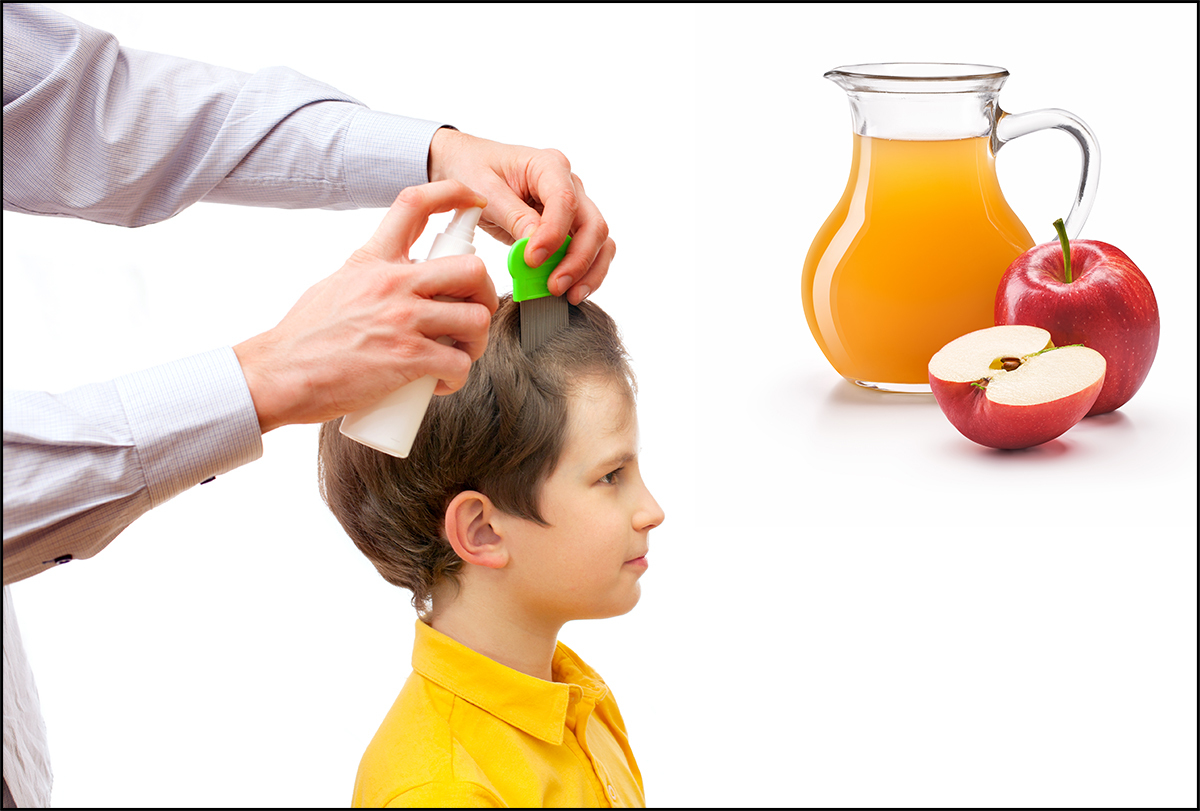
The answer to this question is not a straightforward one. Vinegar is not toxic to lice, so it doesn’t essentially kill them, but it can help get rid of the nits or lice eggs attached to your hair to control the infestation.
These tiny eggs hatch after 7–9 days to produce new lice, which can survive for 3–4 weeks if left untreated and lay more eggs to continue this cycle of infestation.
However, the acidic nature of ACV corrodes the hard protective shell covering the nits to loosen their grip on the hair. As a result, the nits either fall off on their own or can easily be dislodged with a fine-toothed comb.
Plus, ACV can be strong enough to kill the recently hatched lice called nymphs.
ACV, which contains 5%–7% acetic acid, is considered safe for topical use. A higher concentration can be too harsh for your skin; it can dry out, damage, and irritate your scalp and also damage your hair. A lower concentration will also not be strong enough to loosen the nits stuck to your hair.
Experts generally recommend using unfiltered ACV with around 5% acetic acid to be the best choice for treating head lice. (1)
Different Ways to Use ACV for Lice Control
ACV is easy to use at home. Follow these remedies to free yourself from lice infestation:
1. Wash your hair with vinegar
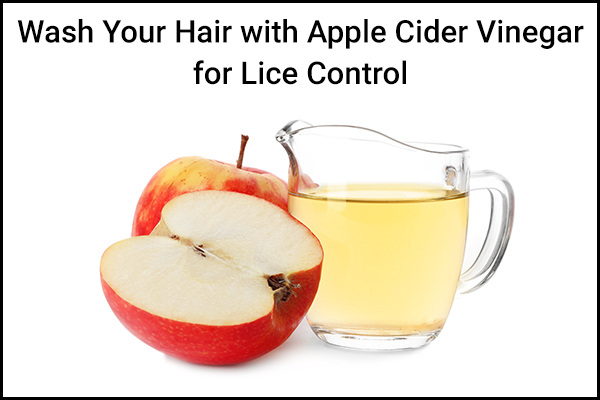
- Mix 1 cup of ACV with the same amount of warm water.
- Spread this mixture all over your scalp and hair.
- Wear a hair cap to avoid dripping and leave it on for about half an hour.
- Rinse your hair normally with regular shampoo and plain water.
2. Use a mixture of essential oils

- In a bowl, put 50 mL each of ACV and coconut oil as well as 2–3 drops each of tea tree oil and ylang ylang essential oil. Mix all the ingredients well.
- Directly apply this mixture to your hair and leave it on for 20 minutes.
- Wash it off with your usual shampoo and water.
- Run a fine-tooth nit comb through your hair to dislodge the lice eggs.
- Wash your clothes in hot water to kill any lice or nits that may have fallen on them.
- Repeat this procedure after 9 days.
3. ACV and olive oil
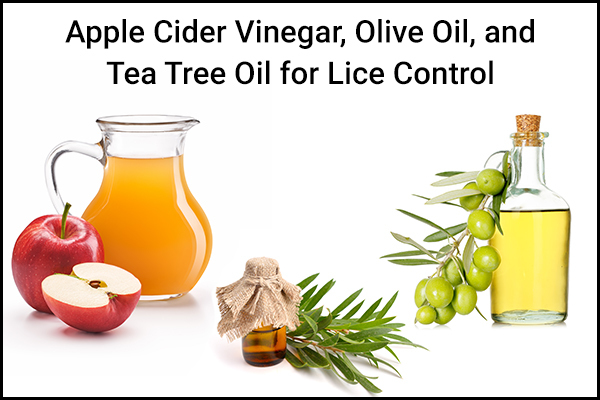
- Pour 5–10 drops of tea tree oil in ¼ cup of lukewarm olive oil and mix them well.
- Generously apply this mixture to your hair and scalp.
- Put on a shower cap and wait for an hour.
- Use a nit comb to pick out any lice and eggs.
- Wash your hair and scalp with warm water and a little shampoo.
- Soak your hair with ACV.
- Wear a shower cap and wait for another hour.
- Again, use the nit comb to weed out any remaining lice eggs.
- Wash your hair with a nice-smelling shampoo to get rid of the pungent vinegar smell.
- Repeat the process after a week.
4. ACV, salt, and oil
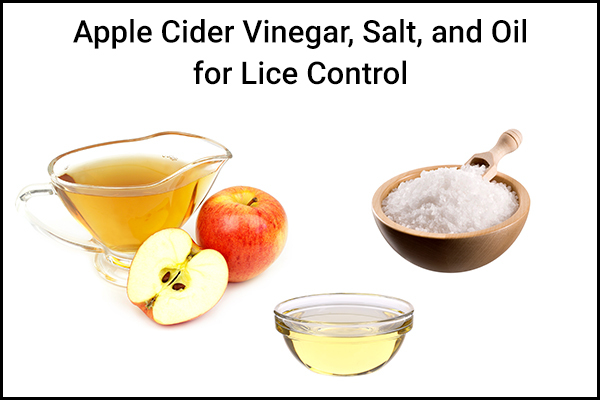
- Heat ¼ cup of ACV to make it comfortably warm.
- Mix in ¼ cup of salt until it dissolves completely.
- Pour the mixture into a spray bottle for easy application.
- Spray generous amounts of the mixture all over your hair and scalp such that they become wet.
- Let your hair dry on its own.
- Apply warm coconut or olive oil to your scalp and hair.
- Let it sit for an hour at least to suffocate any active lice.
- Use a nit comb to remove the stunted lice.
- Wash your hair with shampoo.
- Repeat the process after a week.
How to Prevent Getting Head Lice
If you or your child has a lice infestation, adopt the following measures to control its spread and avoid re-infestation:
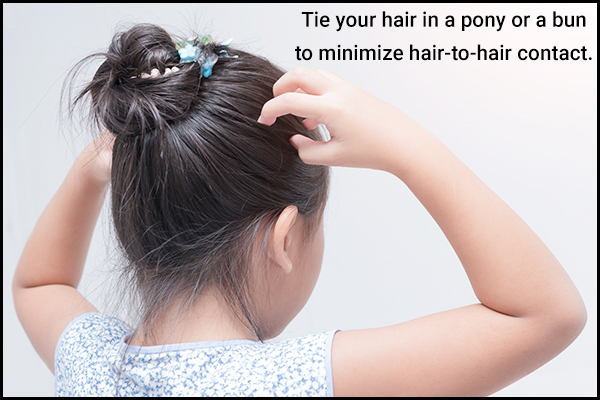
- Tie your hair in a pony or a bun to minimize hair-to-hair contact.
- Any item that was in contact with your lice-ridden head must be soaked and washed in hot water (at least 130°F). This includes your pillowcases, caps, scarves, combs, and brushes. It’s best to wash your bed linen and clothes as well since lice often fall on these surfaces and stick to the fabric. The high temperature kills the lice and nits to disinfect these items. (2)
- If your child has lice, inform the school administration so that they can take the required measures to protect other children from getting the infestation.
- Strictly ask your child not to share any of his/her personal items with others as these may carry lice.
- Children should be cautioned against engaging in any head-to-head contact with other kids during play and other activities.
- When you have an active lice infestation, try not to lay on any bed, sofa, pillow, or rug that is also used by others.
- Once you complete your treatment with lice medication, check your family members for lice after one week. If someone else shows signs of an active lice infestation, contact your doctor for further treatment. (3)
When to See a Doctor
Lice infestations are most common among children, but they can be hard to detect due to the tiny size of these creatures.
This condition generally leads to constant itching and red bumps on the scalp, and parents and even doctors can mistake these symptoms for something else such as scalp irritation or allergy. So, you may want to consult a dermatologist to get a proper diagnosis and seek the best treatment for your little one.
The doctor may prescribe a medicated shampoo or other topical agents along with self-care measures. An expert can also show you the correct technique for removing lice and nits with a fine-tooth comb. Getting professional medical help will help ease your anxiety regarding your child’s condition. (4)
Final Word
Since ACV is ineffective against mature lice and mostly works to loosen nits, don’t expect this remedy to get rid of the infestation with just one application.
You have to use it consistently and properly to remove all the nits from your hair so that the next round of lice are not born, while the existing ones die after completing their average lifespan of 3–4 weeks.
So, if you are just planning on using ACV for head lice, it may take a full month for the infestation to completely go away. If this remedy doesn’t work for you, ask your doctor to recommend an alternative treatment.
- Was this article helpful?
- YES, THANKS!NOT REALLY


